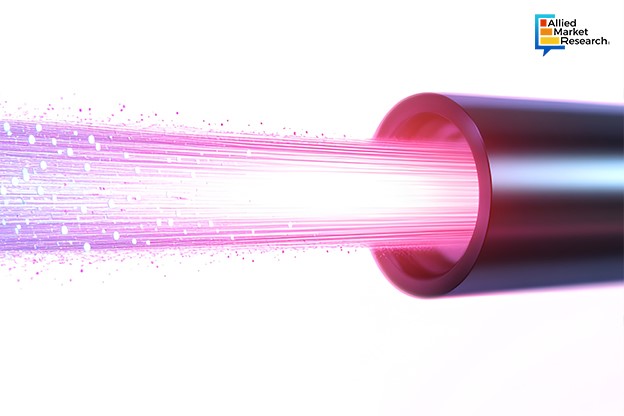Fiber Bragg Gratings (FBGs): Studying the Applicability of Novel Reflectors in Various Sectors

24 Mar
2025
Highlights:
- Introduction
- Rising utility of FBGs in various sectors
- Launch of novel products in the industry
Fiber Bragg grating (FBG) is an optical filter that reflects specific wavelengths of light and transmits the rest. Their ability to selectively reflect different wavelengths of light makes them an essential component of optical fibers. FBGs are now widely used in telecommunication and construction applications, including structural infrastructure health monitoring, wavelength division multiplexing (WDM), etc. The launch of 5G technology in various developed and developing countries has increased the demand for optical fibers, thereby enhancing the utility of FBGs. Over the last few years, the applicability of FBGs in aerospace and defense sectors has improved significantly, thereby expanding the scope of the industry.
The growing applicability of FBGs in various end-use sectors helping the industry flourish
As compared to copper cables that were originally used for voice transmission, optical fibers offer much higher bandwidth. Hence, they carry much more data than traditional wires having the same diameter. The use of FBGs also improves the distance over which data can be transmitted through these cables. Typically, 10 Gbps single-mode wires are able to carry signals for more than 40 km, which is significantly higher than regular copper wires.
Another reason behind the growing utility of FBGs is that they aid in enhancing the reliability of optical fibers by making them immune to temperature, pressure, and moisture changes. The performance of traditional copper wires depends mainly on the climate conditions, thus making them prone and vulnerable to extreme weather events. However, since fibers are good insulators, they do not carry any electric current which makes them immune from electromagnetic induction. Fiber Bragg Grating further improves the insulation properties of the optical fiber, thereby making it a much safer option as compared to conventional wires. Due to these reasons, optical fibers are widely used in various end-use industries such as oil and gas exploration and chemical production.
Along with this, the utility of Fiber Bragg grating (FBGs) has increased exponentially with the rise of IoT-enabled smart devices. Apart from improving the reliability of fiber optic cables, FBGs also enhance the accuracy of data transmission, making them ideal for applications like industrial automation and smart homes. These devices also aid in real-time monitoring and data capture due to their highly sensitive nature. This quality of FBGs has led to a surge in their usage in aerospace and military applications, thereby expanding their utility in various sectors of the global economy.
Launch of ingenious products by multinational corporations opening new investment avenues
Technological advancements in fiber optic technology are expected to help the Fiber Bragg grating industry gather a revenue of $13.6 billion by 2032. The market accounted for $2.0 billion in 2023, rising at a CAGR of 24% during 2024-2032. The expansion of telecommunications, construction, and aerospace and defense sectors has further boosted the revenue share of the industry. Along with this, several major companies have launched innovative products that have enabled them to address the evolving dynamics of the market in the long run.
For instance, in June 2023, Advanced Fiber Resources, a telecommunications equipment company, announced the launch of ClearCut Raman Scattering Suppression FBG. Designed for high-end applications, this device has a low-temperature slope, low insertion loss, and great immunity against extreme weather events. Furthermore, AFR also provides these components based on the client’s tailored needs related to fiber type, package size, power handling, and other such specifications.
Again, in June 2024, TeraXion Inc., an indie semiconductor company, announced the launch of a new line of WaveShift FBG reflectors for Raman Fiber Lasers (RFL). Developed for the healthcare and medical sectors, these solutions offer high wavelength accuracy, reflectivity, and side-mode suppression ratio. As per the press release issued by the company, these FBGs are ideal for biomedical, telecommunication, laser pumping, and spectroscopy applications.
To conclude, the growth of the Fiber Bragg grating (FBG) industry is attributed to the rise in the applicability of fiber optic cables in modern telecommunication applications. Furthermore, the reliability, accuracy, and resilience offered by these components have enhanced their utility in the aerospace and defense sector. The advent of IoT technology is expected to expand the scope of the industry in the coming period.
Get in touch with our experts for the latest trends and advancements in the market!

Akhilesh Prabhugaonkar
Author's Bio- Akhilesh Prabhugaonkar holds a bachelor’s degree in Electronics Engineering from the reputed Vishwakarma Institute of Technology. He has a special interest in the fields of forensics, world history, international relations and foreign policy, sports, agriculture, astronomy, security, and oceanography. An ardent bibliophile and melophile, Akhilesh loves to write on topics of his interest and various other societal issues. This love for writing made him enter the professional world of content writing and pursue his career in this direction.
Avenue: Entire Library membership of Allied Market Research Reports at your disposal
- Avenue is an innovative subscription-based online report database.
- Avail an online access to the entire library of syndicated reports on more than 2,000 niche industries and company profiles on more than 12,000 firms across 11 domains.
- A cost-effective model tailored for entrepreneurs, investors, and students & researchers at universities.
- Request customizations, suggest new reports, and avail analyst support as per your requirements.
- Get an access to the library of reports at any time from any device and anywhere.
Related Post
-
How are Submarine Cables Transforming Global Connectivity with Enhanced User Experience?
-
Endoscopy Procedures: Transformations in Techniques and Applications
-
AI-Powered Video Analytics: How the Product Actually Works for enterprises
-
Painting Robots: Transforming Precision Coating and Creative Applications
-
Innovations in Pharmacovigilance Systems Advancing Patient Safety
-
Understanding Edge Security: Keeping Data Safe Near the Source
-
Exploring the Use and Advancements of 3D Laser Scanners in Professional Applications
-
Reinforcing Industrial Controls with Smarter Tools and Training








